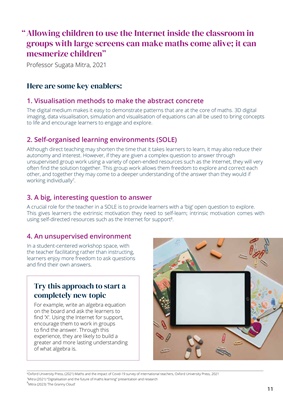
11
" Allowing children to use the Internet inside the classroom in
groups with large screens can make maths come alive; it can
mesmerize children"
Professor Sugata Mitra, 2021
Here are some key enablers:
1. Visualisation methods to make the abstract concrete
The digital medium makes it easy to demonstrate patterns that are at the core of maths. 3D digital
imaging, data visualisation, simulation and visualisation of equations can all be used to bring concepts
to life and encourage learners to engage and explore.
2. Self-organised learning environments (SOLE)
Although direct teaching may shorten the time that it takes learners to learn, it may also reduce their
autonomy and interest. However, if they are given a complex question to answer through
unsupervised group work using a variety of open-ended resources such as the Internet, they will very
often find the solution together. This group work allows them freedom to explore and correct each
other, and together they may come to a deeper understanding of the answer than they would if
working individually7.
3. A big, interesting question to answer
A crucial role for the teacher in a SOLE is to provide learners with a 'big' open question to explore.
This gives learners the extrinsic motivation they need to self-learn; intrinsic motivation comes with
using self-directed resources such as the Internet for support8.
4. An unsupervised environment
In a student-centered workshop space, with
the teacher facilitating rather than instructing,
learners enjoy more freedom to ask questions
and find their own answers.
Try this approach to start a
completely new topic
For example, write an algebra equation
on the board and ask the learners to
find 'X'. Using the Internet for support,
encourage them to work in groups
to find the answer. Through this
experience, they are likely to build a
greater and more lasting understanding
of what algebra is.
6Oxford University Press, (2021) Maths and the impact of Covid-19 survey of international teachers, Oxford University Press, 2021
7Mitra (2021) "Digitalisation and the future of maths learning" presentation and research
8
Mitra (2023) 'The Granny Cloud'